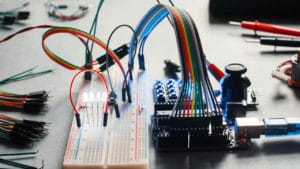Introduction This article provides an introduction to DoD policy, guidance and the acquisition process. E3 is defined as the impact of the Electromagnetic Environment (EME) upon the operational capability of military forces, equipment, systems, and platforms. E3 encompasses all electromagnetic disciplines, including Electromagnetic Interference and Electromagnetic … [Read more...]
EMI Troubleshooting with Real-Time Spectrum Analyzers
The latest tool for serious EMI troubleshooting or debugging has become the real-time (RT) spectrum analyzer. Because manufacturing costs have been decreasing, some RT analyzers are becoming more affordable than ever. In this article, I’ll show you the advantages in using RT analysis for observing and troubleshooting unusual EMI. INTRODUCTION First, let’s review the … [Read more...]
Review of MIL-STD-461 RS101– Radiated Susceptibility, Magnetic Field and RS103 Radiated Susceptibility, Electric Field
Introduction This article discusses RS101 and RS103, including the updates contained in MIL-STD-461 revision “G”, the current revision. These tests quantify the ability of a device to tolerate undesired signals present as a field at the device and associated cables. The field has the potential of coupling the interference into the device circuitry and cause performance … [Read more...]
UNECE Regulation 10: Electrical/Electronic Sub-Assembly Radiated Emissions Testing (Annexes 7 and 8) and Radiated Immunity Testing (Annex 9)
In this installment in the series of blogs on UNECE Regulation 10, Revision 5, Amendment 1 (8 October 2016), hereafter referenced as R10.05, we will look at radiated emissions and immunity testing of Electrical/Electronic Sub-Assemblies (ESAs). ESA RADIATED EMISSIONS (Annexes 7 and 8) Like the vehicle radiated emissions testing annexes, R10.05 has separate … [Read more...]
Basic EMI Concepts
Understanding EMC is all about two important concepts: (1) all currents flow in loops and (2) high frequency signals are propagated as electromagnetic waves in transmission lines and the field energy travels through the dielectric. The two concepts are related because they are intertwined together. Digital signals create the propagating field, which induces the convection … [Read more...]
Oh How I Hate to Commutate!
My favorite Sophomore in Engineering, Roger, and his group, made a small crane for their engineering project. It had many EMC issues. One issue they had was noise from permanent magnet DC motors. I am so glad Roger cares about this issue, because I have modeled a few permanent magnet DC motors, and I can explain how to design it so that then so they are … [Read more...]
UNECE Regulation 10: Vehicle Radiated Emissions & Immunity Testing (Annexes 4, 5 and 6)
Having dealt with the administrative side of Type Approval to UNECE Regulation 10, Revision 5, Amendment 1 (8 October 2016), hereafter referenced as R10.05, in the first three blogs in this series, this installment begins looking at the tests themselves commencing with the radiated emissions requirements of Annexes 4 and 5 and radiated immunity requirements of Annex … [Read more...]
Review of MIL-STD-461 RE101– Radiated Emissions, Magnetic Field and RE102 Radiated Emissions, Electric Field
Introduction This article discusses RE101 and RE102, including the updates contained in MIL-STD-461 revision “G”, the current version. These tests quantify undesired signals being radiated into the air from a device and the associated cables. If unchecked, these signals couple onto other equipment cables or may enter into the other equipment chassis and onto internal … [Read more...]
If You Don’t Like Modeling with a Computer, Try Using Tape and Foil
I am so excited! My son Roger, a Sophomore in engineering, is learning how to make models in JMAG for his internship. He was talking about what great insight a mathematical model gives, and I said that it was possible to make a physical model (a scale model) instead. In the old days, it was quicker and gave different insight than a mathematical model imparts. An old physical … [Read more...]
Review of MIL-STD-461 CE101– Audio Frequency Currents and CE102 Radio Frequency Potentials – Power Leads
Introduction This article discusses CE101 and CE102, including the updates contained in MIL-STD-461 revision “G”, the current version. The test title for CE101 “Conducted Emission Audio Frequency Currents, Power Leads” and for CE102 “Conducted Emissions Radio Frequency Potentials, Power Leads” provide insight into the test frequency range and methods of measurement. These … [Read more...]
- « Previous Page
- 1
- …
- 7
- 8
- 9
- 10
- 11
- …
- 16
- Next Page »














